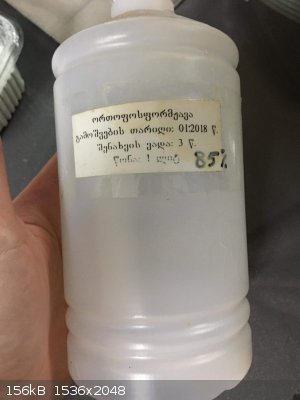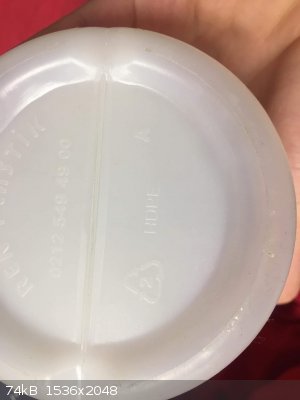NaK
Hazard to Self
 
Posts: 83
Registered: 12-9-2019
Member Is Offline
|
|
Can you store 95% sulfuric acid in HDPE for a long time?
I have some concentrated sulfuric acid that will hopefully last for many years, decades even. It is stored in HDPE currently but I noticed a bit of
yellowing of the plastic in an older bottle. Will this hold up long term or do I need to rebottle it in glass? I really like the unbreakable nature of
the plastics but I also don't want to have half of the bottle dissolved in the acid
|
|
|
itsallgoodjames
Hazard to Others
  
Posts: 276
Registered: 31-8-2020
Location: America Lite
Member Is Offline
|
|
If the bottle or the acid is getting discoloured, you want a new bottle. You can get shatter resistant glass reagent bottles.
Nuclear physics is neat. It's a shame it's so regulated...
Now that I think about it, that's probably a good thing. Still annoying though.
|
|
|
vano
National Hazard
   
Posts: 661
Registered: 22-3-2019
Location: Georgia
Member Is Offline
|
|
98% sulfuric acid, which I buy is poured into HDPE bottles.
This is a phosphoric acid, but sulfuric acid is in same 1L bottle.
 
|
|
|
Fyndium
International Hazard
    
Posts: 1192
Registered: 12-7-2020
Location: Not in USA
Member Is Offline
|
|
They store sulfuric acid almost exclusively in HDPE canisters. I've always got mine in them, even the brand reagent grade ones. Never seen a glass
bottle for it. Plastic, when allowed, is superior to glass in every way as a storage media.
If picking a new container, just make sure it is unadulterated HDPE, as many commercial plastics contain filler like calcium carbonate or other cheap
stuff that lowers the bulk price of the plastic without affecting it's structural properties and allow it to be suitable for food packing and other
not-too-reactive stuff, but may cause reaction with strong acids.
Sulfuric acid, especially technical grade ones, often comes naturally in slightly yellowish tint. Mine is at 98% pure, and it does not affect anything
in any way.
|
|
|
vano
National Hazard
   
Posts: 661
Registered: 22-3-2019
Location: Georgia
Member Is Offline
|
|
Mine is pure too. I can buy 95 or low concentrated sulfuric acid, which used in car batteries, but as you mentioned it has yellowish colour and i dont
like this. I only have two technical reagents, first is calcium hypochlorite and ammonium nitrate from 50kg fertilizer packet.
|
|
|
FrenchChemist
Harmless

Posts: 43
Registered: 25-1-2021
Member Is Offline
|
|
HDPE do the job for sulfuric, nitric also but for longer time only glass, maybe it was due to a faulty hdpe bottle art, nitric acid started to
"condense" on the outside of the bottle, I had to transfer to the glass. After a year, nothing happens. Come on as I say maybe my HDPE container was
defective
|
|
|
woelen
Super Administrator
        
Posts: 8014
Registered: 20-8-2005
Location: Netherlands
Member Is Offline
Mood: interested
|
|
I also had sulfuric acid in HDPE bottles, but over time, the plastic became darker and darker grey. I decided to pour all acid in glass bottles. My
acid is not slightly yellow or brown, it really is colorless like water, and in glass it remains that way.
Sulfuric acid, when sold for technical purposes, indeed usually is shipped in plastic bottles, but I also have a bottle of sulfuric acid, which is
intended as a lab reagent. This is in a nice glass bottle, with a sturdy black cap, which has a white teflon liner inside.
|
|
|
Sulaiman217
Harmless

Posts: 5
Registered: 8-5-2019
Location: Saudi Arabia
Member Is Offline
Mood: ionized
|
|
In my country you can buy 98% H2SO4 in almost all plumbing shop as drain opener. It is supplied in HDPE bottles. I bought 2 liters bottle back in the
epedmic breakthrough ( around march 2020). I keep it in its bottle and frequently top up my Reagent bottle from it. Lately i am observing a slight
discolor to the acid where it used to be very clear like water. That change in color never effected any reaction however.
|
|
|
FrenchChemist
Harmless

Posts: 43
Registered: 25-1-2021
Member Is Offline
|
|
Yes, this PTFE liner are the best , so far i have storage problems only with PCl3 , but glass ampoule did the job or Schott DURAN Premium caps
Quote: Originally posted by woelen  | I also had sulfuric acid in HDPE bottles, but over time, the plastic became darker and darker grey. I decided to pour all acid in glass bottles. My
acid is not slightly yellow or brown, it really is colorless like water, and in glass it remains that way.
Sulfuric acid, when sold for technical purposes, indeed usually is shipped in plastic bottles, but I also have a bottle of sulfuric acid, which is
intended as a lab reagent. This is in a nice glass bottle, with a sturdy black cap, which has a white teflon liner inside. |
|
|
|
Belowzero
Hazard to Others
  
Posts: 173
Registered: 6-5-2020
Location: Member Is Offline
Member Is Offline
|
|
Quite often the caps are the weakest point.
And as mentioned above HDPE bottles tend to sweat over time.
I would vote against long time storage (years on end) of sulfuric acid in HDPE bottles.
Also I have a couple HDPE bottles of battery acid which seems to hold much better due to its lower concentration.
[Edited on 16-4-2021 by Belowzero]
|
|
|
woelen
Super Administrator
        
Posts: 8014
Registered: 20-8-2005
Location: Netherlands
Member Is Offline
Mood: interested
|
|
Battery acid is no problem, the concentrated acid is (in the long run).
Concentrated HCl (37%) is a problem as well. The bottle gets wet on the outside. Even with 30% HCl this problem occurs, albeit less severely.
I store all my concentrated acids in glass bottles with suitable caps. I now have 4 liters of H2SO4, long term storage, which I keep, now that in the
EU the concentrated acid cannot be purchased anymore. These 4 liters will last many years to come for me, and in those years they should remain nice
waterclear as they are now. We now can buy 15% acid in 25 liter jerrycans for a little over EUR 1 per liter and I keep that in plastic, it is dilute
and keeps well. Many experiments can be done with this 15% acid and the concentrated acid only is needed occasionally.
[Edited on 16-4-21 by woelen]
|
|
|
greenlight
National Hazard
   
Posts: 740
Registered: 3-11-2014
Member Is Offline
Mood: Energetic
|
|
I have a large supply that has been stored for a decade now in black HDPE 15L jugs at about 15-25°C.
The only difference is it is much darker now after such a long time. Still functions as required and quickly carbonizes paper towel.
Be good, otherwise be good at it 
|
|
|
Fyndium
International Hazard
    
Posts: 1192
Registered: 12-7-2020
Location: Not in USA
Member Is Offline
|
|
I have also a HDPE bottle of 98% sulfuric acid over a decade old without single hint of issue.
|
|
|
woelen
Super Administrator
        
Posts: 8014
Registered: 20-8-2005
Location: Netherlands
Member Is Offline
Mood: interested
|
|
For me, acid getting brown or darker IS an issue. It still may be fine for carbonizing paper or cleaning drains, but if you do experiments with e.g.
transition metal complex formation, then any colored impurity is a big pain in the ass. So, for me, any container, which adds crap to my chemicals, is
unfit for the purpose of storing that chemical. Some chemicals can be stored in nearly every container, while others require much more care in
selecting a suitable container. Sulphuric acid is in the middle of the scale.
|
|
|
Fyndium
International Hazard
    
Posts: 1192
Registered: 12-7-2020
Location: Not in USA
Member Is Offline
|
|
I would just get a separate glass bottle for more special purposes and keep the rest of the 25 liters in a can. That's actually what I do with any
stuff I got more than a bottle: I keep one bottle at hand for use, and refill it as needed from the drum. It's difficult to fill a 100mL cylinder from
25L canister anyway. Pun intended.
How do you emigrate there? I'm getting tired of this shit.
[Edited on 18-4-2021 by Fyndium]
|
|
|